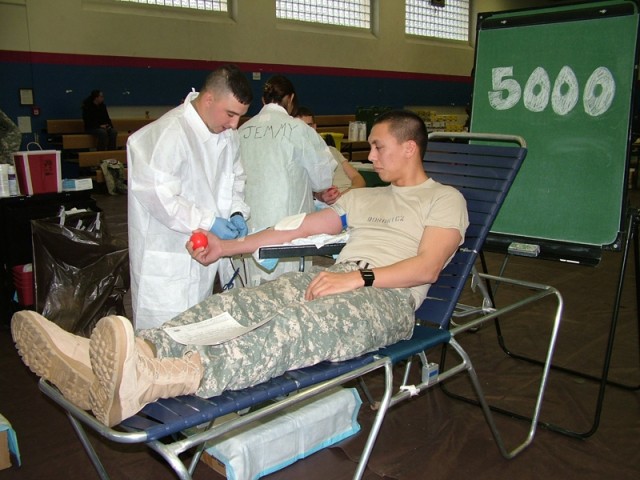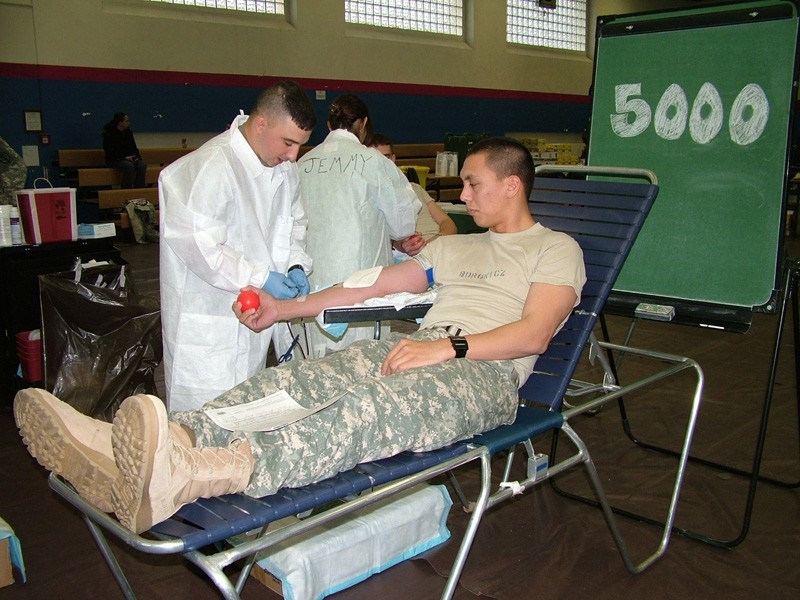DARMSTADT, Germany - 2nd Lt. Alex Borowicz believed he was just doing his job when he stopped by the Kelley Barracks Fitness Center right before Christmas to donate blood for fellow Soldiers downrange.
What Borowicz didn't know - until he was already seated in a lounge chair, squeezing away at a bright red ball and cracking jokes with Hospitalman Corpsman First Class Michael Beam - was that his donation became the 5,000th complete unit of blood contributed to the Armed Services Blood Program in 2007 from servicemembers stationed in Europe.
Capt. Phillip Bossart, chief of the Armed Services Blood Bank Center-Europe, said as a mobile blood bank team prepared for a quarterly 66th Military Intelligence Group blood drive here, a staff member noticed the center was close to setting a milestone.
Bossart explained, "We've never approached that number, never even thought of it," so when the issue arose, the team checked their records. It was then that the team realized, according to Mike Peacock, blood donor recruiter for ASBBC-Europe, that they were just 36 complete units shy of the 5,000 mark.
Peacock alerted the 66th MI Group, which spread the word in Darmstadt that their quarterly blood drive had the potential to break a record. As Peacock explained, ASBBC-E regularly receives between 50 and 75 units of blood at each Darmstadt drive, and the team was confident that they would reach their goal at the 66th MI event.
However, Peacock believes the overall accomplishment belongs to the "entire European community of donors; we owe it all to them."
The fact that the 5,000-unit achievement was even in their grasp, said Bossart, resulted from the commitment of the European Command donor base population and the Landstuhl blood donor team (ASBBC-Europe).
"It's the people," he said. "They accept the mission and really work to get the word out."
And thanks to an aggressive publicity push, entire units contacted the program, scheduling drives across Europe. "The media attention really opened the floodgates," Bossart said.
Other factors also contributed to the year-long success for the Armed Services Blood Program, said Maj. Jose Quesada, director of blood services for Landstuhl Regional Medical Center. The consolidation of the RAF Lakenheath, England, donor program with Landstuhl provided a truly joint-service system, incorporating Army, Air Force and Navy efforts.
With more improvements on the way, including installation of aphaeresis machines at Landstuhl to process platelets and plasma donations, and the introduction of safer donation bags with a built-in diversion pouch, Quesada believes ASBBC-E will continue expanding its reach and the number of lives it can save.
In December, however, the focus remained on donor 36 - the magic number that would launch the ASBBC-E to a new record.
Anticipating the lucky volunteer became a rapid-fire guessing game, as all potential donors are not eligible to donate. Plus eligible donors still had to complete a standard 30-minute screening process meant to protect the U.S. military's blood supply. As donors moved through the line, Quesada reminded every person - including Spc. Rachel Narey, a nervous first-time giver contributing a pint for her two brothers downrange - that each donation was just as important as the 5,000th.
Borowicz, the new executive officer for Headquarters and Headquarters Company, 66th MI Group and sponsor of the blood drive, just happened to come through the line at the right time.
"I thought it could be me," he recalled, "because I knew they were aiming for that number."
As Borowicz finished giving his pint and Beam removed the needle from his arm, the Armed Services Blood Program team presented the lieutenant with a shirt, engraved glassware and a coin.
A little overwhelmed by such attention, he said: "I just gave blood ... and here they are giving me all this stuff. I was just doing my duty as a Solider, so the people downrange have what they need to focus on their jobs ... to make sure we provide our brothers and sisters with the blood they need."


Social Sharing